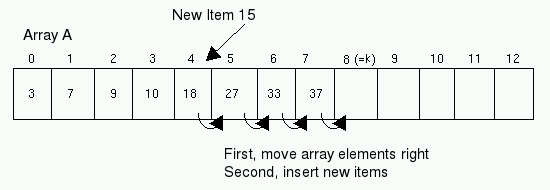Reading: Insertion Sort
Abstract
Many applications require that data be ordered and maintained. Some
examples of humans manually using insertion sort include sorting a
deck of cards, or sorting books on a bookshelf.
In C and many other languages, a simple way to structure ordered data
is in an array (or vector), such as the following ordered array
A of integers.

The Insertion Sort
One common sorting approach is based on code that assumes that the first
part of an array is ordered and then adds successive items to this array
segment until the entire array is sorted. To understand this approach,
we first consider how to add one item to an ordered array segment.
We then apply this work to each array element in turn to yield an ordered
array.
Maintaining An Ordered Array Segment
Suppose items A[0], ..., A[k-1] are ordered in array A:

To insert an item into the first part of this array and
maintain the ordering, we proceed from right to left with elements
in the array.
-
We compare item to successive elements at the right of the array.
-
If the array element is bigger than item, we move the
array element to the right.
-
Once we move elements larger than item to the right,
there is room to insert item in its place.
For example, the following figure shows the insertion of the
number 15 into the array A above.

The following code translates this idea into C. When this code
terminates, item is placed into the array, so that items
A[0], ..., A[k] become ordered:
int i = k-1;
while ((i >= 0) && a[i] > item){
a[i+1] = a[i];
i--;
}
a[i+1] = item;
Using this basic insertion step, an array A can be sorted
iteratively according to the following outline:
-
Consider A[0] as a sorted initial segment of array A.
(That is, in the example, consider k = 0.)
-
Insert A[1] into segment A[0] to get ordered segment
A[0], A[1].
-
Insert A[2] into segment A[0], A[1] to get ordered segment
A[0], A[1], A[2].
-
Insert A[3] into segment A[0], ..., A[2] to get ordered
segment A[0], ..., A[3].
-
Insert A[4] into segment A[0], ..., A[3] to get ordered
segment A[0], ..., A[4].
-
Et cetera.
Insertion Sort Example
Animation borrowed
from Wikipedia.org
under a Creative Commons license.

This outline gives rise the the following code, called an insertion
sort.
void insertionSort (int a [], int length) {
// method to sort using the insertion sort
// parameters: a, the array to be sorted
// length, the size of the a array
for (int k = 1; k < length; k++) {
int item = a[k];
int i = k-1;
while ((i >= 0) && a[i] > item){
a[i+1] = a[i];
i--;
}
a[i+1] = item;
}
}
It is important to notice that the item being compared is not
switching place with each item it compares to. The items that are
compared against are shifted; the element being compared is
inserted.
Programming Note
The array parameter for insertionSort may be specified in either
of two, interchangeable ways:
-
int a [] (used here) emphasizes that parameter a will be
an array of int values.
-
int * a highlights that an array parameter is the base address of
an array of int values. From this perspective, the base address
of an array is the address of the initial int value or an
int .
As already noted, the two parameter declarations are equivalent and
may be used interchangeable.
Insertion Sort Characteristics
This sorting algorithm has several helpful properties.
The insertion sort is
-
relatively simple,
-
efficient for small data sets and data sets that are already partially
sorted,
-
stable in the sense that it does not switch identical elements, and
-
only requires a constant amount of additional memory space (that is,
the amount of memory for the set of elements, plus memory for one
element of the set).
The amount of time this algorithm takes to sort a set is dependent
upon the set itself.
-
For any data set, each successive array element must be compared to
the array element just before it.
-
In the best case, each successive array element will already be larger
than its predecessor, and no array elements will need to be moved.
-
In the worse case, each successive array element will be smaller than
its predecessors, and all array elements on the left will need to
be moved to the right with each insertion.
-
If the array data start in random order, each successive array element
will be larger than some elements to its left and smaller than other.
On average, we might have to shift about half elements on the left
over to make room for successive array elements.
Overall, for a set with n elements, if the set is sorted (or nearly
so), the algorithm takes only a single time unit for each element, so
it takes n time units. On the other hand, if the set is in reverse
order (that is, largest to smallest), the time approaches
n-squared. You will see the previous two statements proven in a later
course.
created 1 August 2011 by April O'Neill
revised 5 August 2011 by April O'Neill
minor editing 7 November 2011 by Henry M. Walker
altered sort header 5 December 2012 by Henry M. Walker
updated and reformatted August-November 2016 by Henry M. Walker
created December, 2021
revised December-January 2021
|


|
|
For more information, please contact
Henry M. Walker at
walker@cs.grinnell.edu.
|




